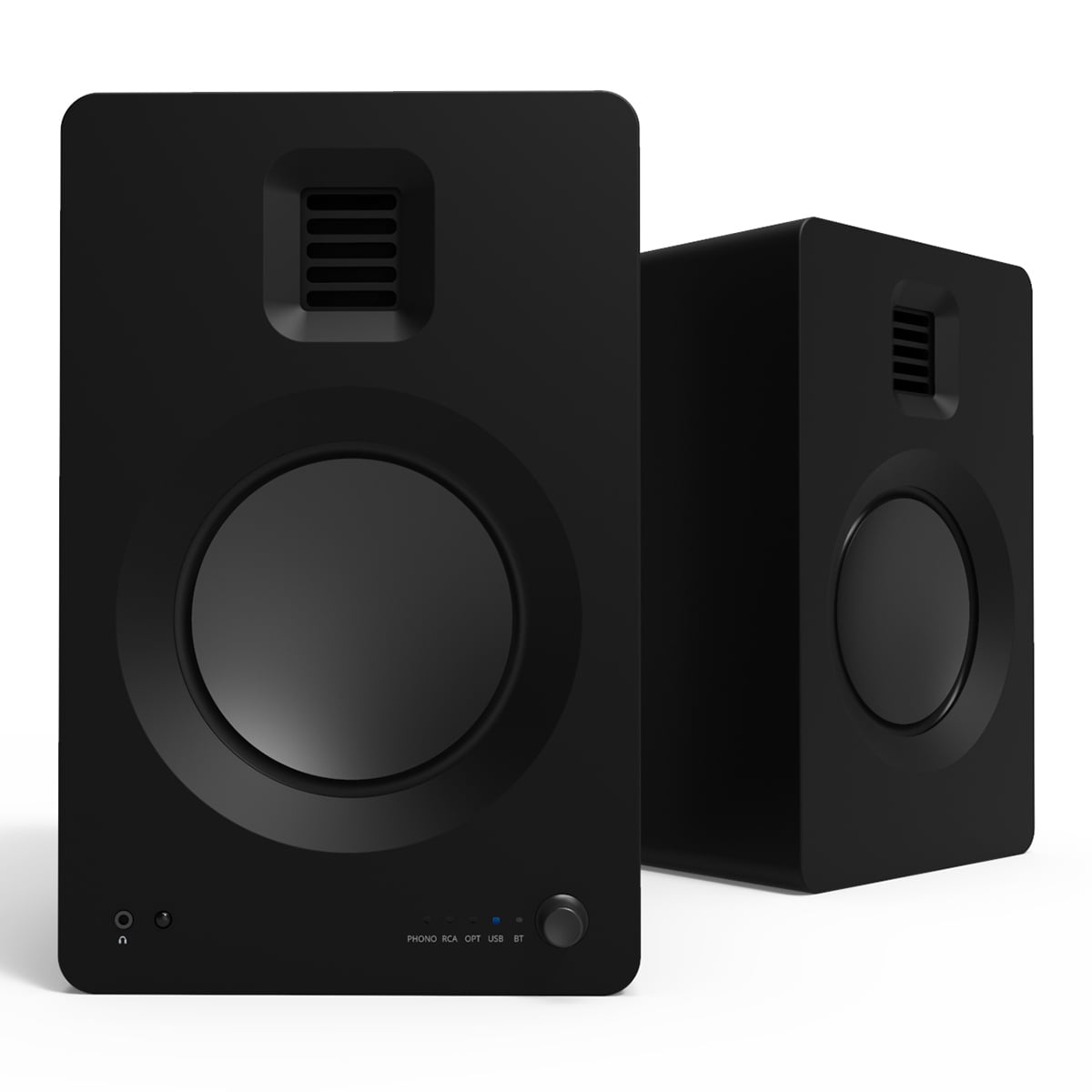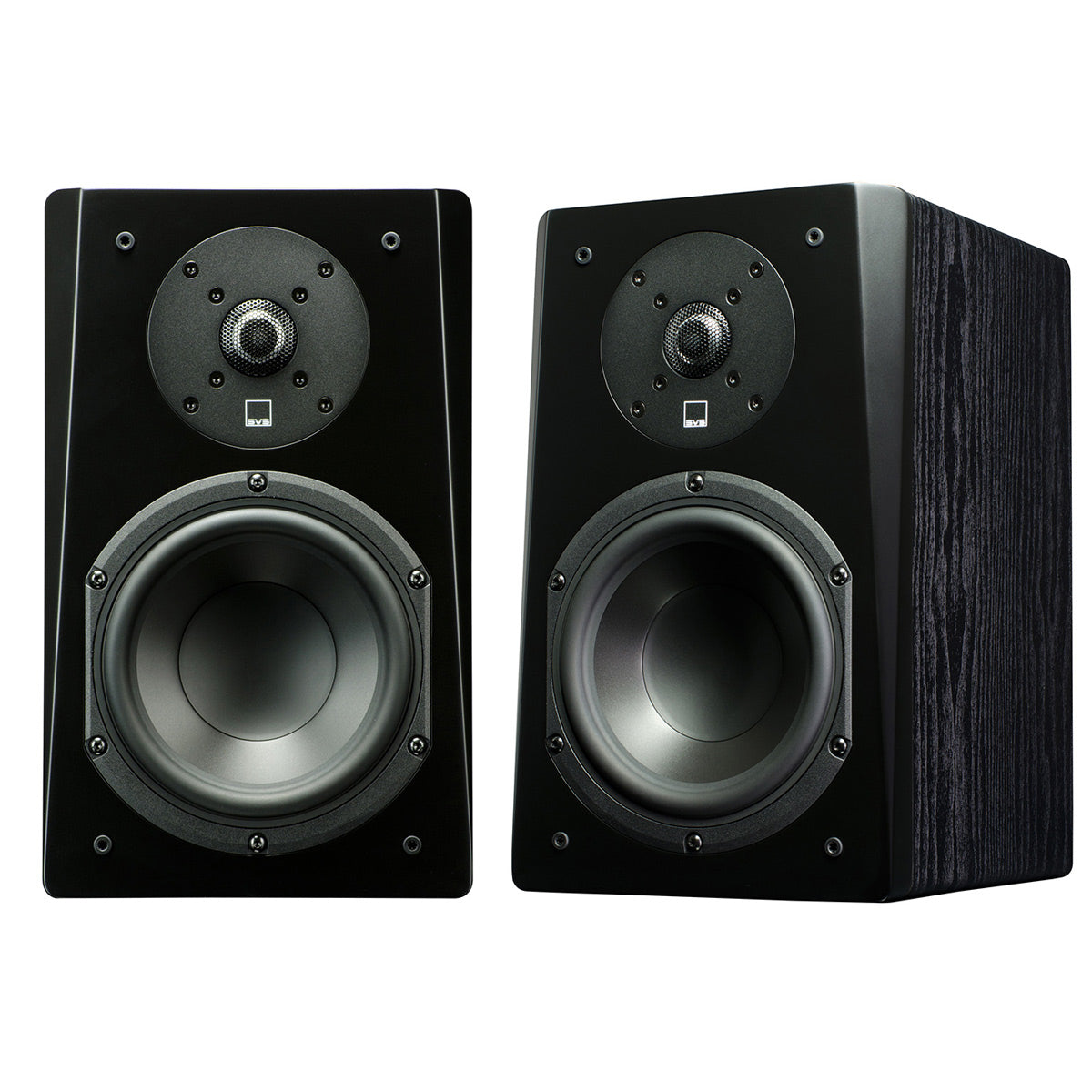Considerations When Buying Bookshelf Speakers
Can you put these on a bookshelf if you really want to? As we’ll see, as long as you follow one simple guideline, the answer is yes. But there are a few other important factors to consider when choosing a speaker to use in your stereo system or home theater, so let’s dig in:
Size Matters, But So Does Distance
In the professional audio world, speakers of this type are called monitor speakers. People who edit audio in the music, film, or TV business will monitor their work on very high-quality speakers that are no bigger than the ones you see in this guide. These are called near-field monitors because they’re intended to be listened to at a close distance. In pro audio, such speakers are expected to have sound that is clear, natural, and uncolored, as well as a superb frequency response from one end of the range of human hearing to the other, and beyond. This helps pro audio editors ensure that the product they’re delivering is accurate and has the highest quality audio possible.
The bookshelf speakers our experts have selected for you in this guide are no different. What sets them apart from larger speakers is simply that these are intended to deliver flawless sound in a smaller space and at a closer range than larger speakers.
A Two-Way Conversation
Typically, bookshelf speakers have a two-way speaker design, which includes a tweeter for high-frequency sounds and a single speaker driver that handles the midrange and bass response of the audio spectrum. When appropriately matched to a room and listened to at a distance intended by the designers, bookshelf speakers can deliver an exquisite listening experience.
Passive or Powered
This can be one of the more tech-y topics for bookshelf speakers, but in the real world, it's a simple decision. Whether you need passive bookshelf speakers or powered bookshelf speakers depends on where your audio is coming from.
If you're looking for wireless connectivity and you're streaming from a device or from a receiver, then you’ll need powered bookshelf speakers with Bluetooth capability, which have their own amplifiers built into them. These powered speakers usually have power cables you'll have to plug in, so they're not entirely wireless. Some powered bookshelf speakers are designed to accept wired inputs directly from your stereo equipment, such as a CD player or turntable. One aspect of powered speaker design that can be an advantage is that the speaker will split the incoming audio into the high frequencies and low frequencies before it amplifies the signals and sends them to their corresponding driver. This can be a plus, depending on where your audio is coming from.
If a receiver/amplifier unit is the heart of your audio or home theater system, then you'll use passive bookshelf speakers. Passive speakers don't have built-in amplifiers of their own; the wired audio signal from your amplifier is at the right level to drive the speakers. If the speakers are designed to work with your amplifier, then they're already set up to make your audio sound the best it can. If not, many passive speakers have controls that you can tweak to adapt to a particular receiver — and this is something that our in-house team of audio experts will be happy to help you with!
All About That Bass Response
In some installations, bookshelf speakers can be augmented with the addition of a subwoofer, or even two. This isn’t necessarily just so you can get your disco on; this can give you a clearer perception of the bass instruments playing in an orchestra, or of the space in which music is recorded, as well as the blood-chilling thud of a dinosaur’s foot in everybody’s favorite subwoofer-oriented film.
More importantly, the addition of a subwoofer can direct the bass in the precise location to give you a perfectly balanced sound. In this regard, bookshelf speakers can offer more flexibility than larger speakers, making it easier to match the characteristics of your space, and give you optimal bass response.
Another important consideration with bookshelf speakers: If you’re going to be placing them in an actual bookshelf, or other similarly enclosed location, or even close to a wall, consider speakers that have front-facing bass ports, rather than rear-facing. Bass ports are openings in the cabinet that enhance the longer waveforms of bass frequencies. If your installation will be away from a wall, then a rear-ported enclosure may be the best choice for your system.
Stand By Your Speakers
For installations not using existing furniture or wall mounts, a very important factor is the type of speaker stands you choose. For one thing, you’re going to want your speakers to be at the ideal height for your ears when you’re in a sitting position. For another, a substantial stand can help ensure that the sound of your speaker gets transferred efficiently. A good stand can also look great with the rest of your furniture.
Another advantage of bookshelf speakers is that you can add more of them to a stereo pair to create a matched surround system. When your side speakers and rear speakers match your front pair, the sound of your home theater can become more coherent and enjoyable.
Whether you call them monitors or bookshelf speakers, these compact units can resemble each other to the untrained eye. Our experts can help you discern the critical differences that will make one or the other of these fine speakers the clear choice for you. Read the reviews in this guide, then if you'd like more information or to consult our team, give us a call.
Still not sure? We got this.
If you’re still not sure which bookshelf speakers are best for you, give us a call or send us an email. Tell us a little about how you will use them, what kind of music and movies you like, what’s your budget, and/or anything else you think we should know. Just think of us as your own personal audio gear shopping concierge, on-call to help you pick the perfect bookshelf speakers for you. Our goal is to help make sure you get what you need to enjoy your favorite music, movies, and shows. If we can get you closer to that with just a conversation, that's great. If you choose to make your purchase with us, we know you'll be very satisfied. With 40 years of building great relationships with our clients and USA Today's #2 rating in customer service, you can count on our having your interests at heart. We're not here to just move boxes out the door!
One more thing...
In the early days of the speaker, it was easy to decide where to buy your speakers: In a brick-and-mortar store, since the Internet wasn't the e-commerce juggernaut it is now. But then as now, the best way to approach your purchase of home theater gear was to buy it from a trusted dealer. And the more experience and longer the track record, the better. Even more so today than 40 years ago, a good dealer will take care of you in the event anything happens.
Speaking of trusted dealers…
World Wide Stereo is home to some 90+ industry-leading audio/video professionals who love what they do, and talking about it, too. We opened our doors in 1979, gained a small yet diehard following, won a slew of national awards for everything from killer car audio installations to customer service, grew the business online… and today we enjoy a faithful following of like-minded TV-watching, music-listening, gear-loving defenders of fun for the whole family. Our only rule: no one leaves unhappy. We’re brutally honest when it comes to this stuff. Want to know if something is as good as advertised? Even if you're shopping somewhere else? Call us or stop by one of our showrooms — we’ll give it to you straight. We love what we do, and we love sharing that love.
With us, you get our guarantee, which includes perks like free shipping, 60-day returns, and support even years after the sale — always. Hence our rule: "no one leaves unhappy." Ever.
Thank you for reading – and enjoy your new speaker system!










